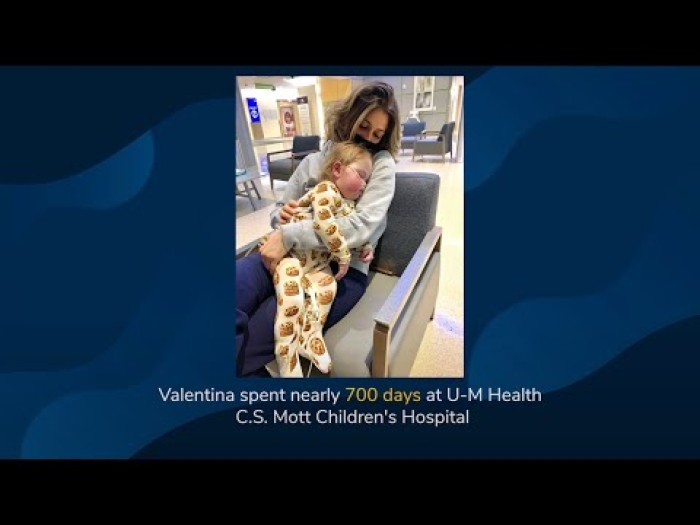How a critical heart defect — found in about 6 in 1,000 infants, and treatable in utero at just a handful of hospitals — was detected and treated, all before baby Breck’s birth.
7:00 AM
Author |

At 28 weeks pregnant, Deena Vroegindewey was admitted for a heart procedure at University of Michigan Von Voigtlander Hospital. But not for her heart — for her unborn baby's.
MORE FROM MICHIGAN: Sign up for our weekly newsletter
Days earlier, an ultrasound showed something wrong with the tiny heart growing inside of her. A severely narrowed valve, known as aortic stenosis, was blocking blood flow to the rest of the baby. The defect was expected to cause worse heart conditions as her baby boy, Breck, grew.
One option: widening the valve before birth.
The family had been referred from their local doctor near Hudsonville, Michigan, to the University of Michigan C.S. Mott Children's Hospital. The Mott Congenital Heart Center is among less than a dozen programs in the country and the only one in Michigan that offers fetal cardiac intervention to treat aortic stenosis in utero.
"Our first reaction was, 'No way. We are not doing that. That sounds way too risky,'" Deena remembers. "But then we learned more about how this could help prevent his condition from worsening. Our doctors even connected us to other families who had done it so we could ask questions —and we asked a lot of questions."
"Once we understood the severity of his condition and that this procedure would put him in the best situation for long-term health, that made it an easier decision," adds Deena's husband, Jeff.
After several lengthy team meetings among doctors and discussions with the family about Breck's case, the surgery was scheduled for January 2016.
Within 48 hours of the diagnosis, Deena had a procedure performed and monitored by a Michigan Medicine team of obstetricians who specialize in high-risk pregnancies, maternal-fetal specialists, pediatric cardiologists and anesthesiologists. As she had epidural anesthesia and was awake the entire time, a nurse held her hand, explaining every step. A small needle was inserted into Deena's belly, allowing a catheter with a tiny balloon at the tip through her uterus and into the baby's heart.
Guided by advanced ultrasound images, doctors inflated the balloon to open the stenotic aortic valve and restore normal blood flow in the heart. Continued blockage of blood flow can negatively affect fetal growth of the left ventricle, which serves as the heart's main pumping chamber.
The procedure lasted less than an hour.
"I was so emotional just knowing that if something went wrong he may not survive," Deena says. "But as soon as they did the echocardiogram [which uses sound waves to take pictures of the heart], we knew he was fine.
"It's crazy to know they were able to do a procedure on his heart before he even came out — and that it worked."
After birth
Critical aortic stenosis affects about 6 in every 1,000 infants born and occurs more often in boys. It may be an isolated defect, but in Breck's case, it occurred with other heart problems that were discovered after he was born last March.
SEE ALSO: Ruby's Story: Normalizing Congenital Heart Defects for Michigan Families
Within five hours of birth, Breck needed another catheter procedure to open his aortic valve even more because of how much his heart had grown since the procedure. Doctors also learned that Breck had mitral valve stenosis, an abnormal valve that wasn't opening properly and was also blocking normal blood flow.
He had two open heart surgeries in his first month of life.
"Fetal cardiac intervention is one of the most innovative treatments that we offer here. We only consider this treatment for very select, severe cases when we believe it will decrease the severity of a child's heart disease," says Mott pediatric cardiologist Sarah Gelehrter, M.D. "Breck was one of those patients."
Gelehrter says blocked blood flow in utero often causes major problems with the growth of the left ventricle, which can become dilated and dysfunctional and lead to hypoplastic left heart syndrome. If the condition grew to affect more than one ventricle, it could require more intensive surgeries down the road.
While Breck still required heart treatment after he was born, protecting the health of his left ventricle before birth "set him up for better outcomes," she says.
This March, Breck celebrates his first birthday. Aside from the faint scar from his two heart surgeries after birth, Breck is a typical 11-month-old who loves to smile at people and play, especially with his brothers, Trace, 5, and Weston, 4.
"We went from thinking we had a completely healthy pregnancy to learning our baby had a major heart condition in just hours," Deena says. "Despite being busy, everyone at Mott spent a lot of time talking to us about the condition and all of the pros and cons of every option. We never felt rushed, and we knew the teams were being very thoughtful and diligent in making the best decision about Breck. We are glad that we had this option for our baby."
"With everything he's gone through, it's given us a new perspective on life with him today," she adds. "All of the little challenges don't even matter compared to what he's gone through. We try not to take anything for granted."

Explore a variety of health care news & stories by visiting the Health Lab home page for more articles.

Department of Communication at Michigan Medicine
Want top health & research news weekly? Sign up for Health Lab’s newsletters today!





